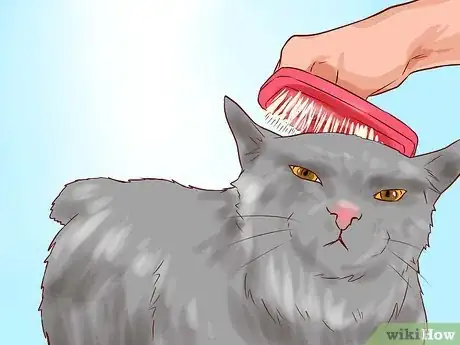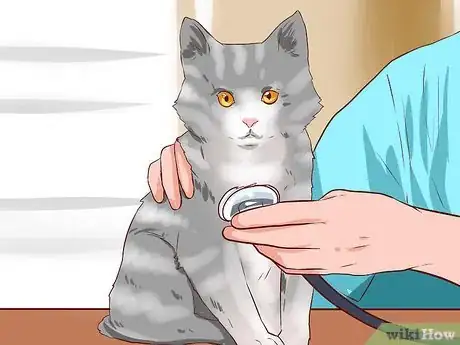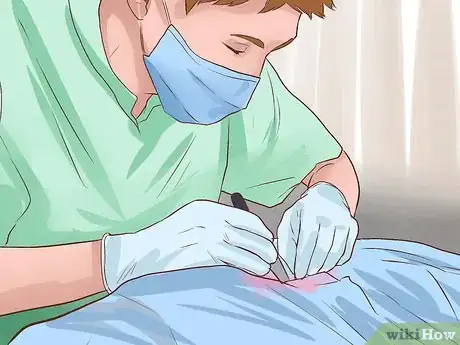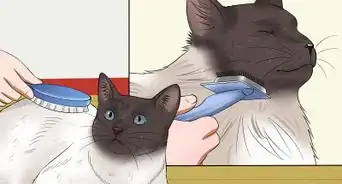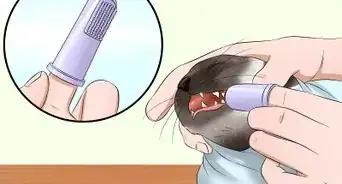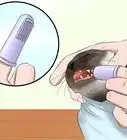This article was co-authored by Pippa Elliott, MRCVS. Dr. Elliott, BVMS, MRCVS is a veterinarian with over 30 years of experience in veterinary surgery and companion animal practice. She graduated from the University of Glasgow in 1987 with a degree in veterinary medicine and surgery. She has worked at the same animal clinic in her hometown for over 20 years.
There are 17 references cited in this article, which can be found at the bottom of the page.
This article has been viewed 21,804 times.
Manx cats are ancient cats that started out on the Isle of Man. These stocky, tailless cats come in short-hair and long-hair varieties. They are known for their intelligence, playful personalities, and excellent mouse-catching skills.[1] If you get a Manx cat, then you will need to care for his nutritional needs, grooming, entertainment, and protection.
Steps
Feeding Your Manx
-
1Select a high-quality cat food. Your Manx cat will require a high-quality cat food to meet all of his nutritional needs. Make sure that you choose a brand name cat food that is meant for cats. Also, if your Manx cat has special dietary needs, then you may need to feed him a special food. For example, if your Manx is overweight or obese, then you may need to give him food that is meant for cats.
-
2Feed your Manx on a regular schedule. Cat food packages provide guidelines for how much you should feed your cat based on his weight. You can use this amount to help you create a regular feeding schedule. Take the amount of food that your Manx is supposed to eat every day and divide it into two portions. Give these portions to your cat in meals spaced about eight to 12 hours apart.[4]
- For example, you could give your cat breakfast at 8:00am and then give her dinner at around 8:00pm.
- Since cats like to eat small meals, giving your Manx two small meals each day should make it more likely that she will eat all of the food she is supposed to each day.[5]
Advertisement -
3Give your Manx plenty of fresh, clean water. Manx cats need access to fresh, clean water at all times. Wash your cat’s water dish every day and make sure that it is always full of fresh, clean water.[6]
- Keep your cat’s food and water bowls away from all litter boxes. Cats don’t like to eat and drink near where they go to the bathroom.
-
4Give your Manx some treats. Cats enjoy having an occasional treat, so keep a bag of treats on hand. Make sure that you do not give your cat too many treats or he may become overweight.[7]
- Limit the number of treats that you give your Manx to about 5% of his total daily calories.
Grooming Your Manx
-
1Brush your Manx’s fur occasionally. Manx cats can have short or long hair, which will affect how much you need to groom your Manx.[8] If your cat’s fur is short, then you can brush it about once per week. If your cat’s fur is long, then you will need to brush your Manx every day.
- If your Manx is shedding, then you may need to brush him more often than usual to get rid of excess hair.[9]
-
2Trim your Manx cat’s claws. Scratching will help to keep your cat’s claws worn down, but you may need to give them a trim now and then to keep them from getting too long. Plan to trim your cat’s claws about once every three weeks.[10]
- Trim the white tips of your Manx’s claws. Be careful not to trim the pink area of your cat’s claws or you may hurt your cat.
- Trim your cat’s nails with a special guillotine style nail trimmer.[11]
- Your veterinarian or a cat groomer can also trim your cat’s claws if you are not comfortable doing so yourself.
-
3Clean your Manx’s teeth. Just like people, cats are prone to dental health problems. Use a special toothbrush and toothpaste for cats to brush your Manx cat’s teeth once per day.[12]
- Only use toothpaste that is meant for cats because fluoride is toxic to cats.
-
4Bathe your Manx if necessary. Your Manx should be able to keep himself clean, so bathing is not usually necessary. However, if your Manx becomes dirty, then you may want to give him a bath. For example, if your cat smells bad or if she gets something sticky on her, then you may need to give her a bath.[13]
Entertaining and Comforting Your Manx
-
1Pet your Manx. Manx cats are great with kids and they make great family pets.[14] Make sure that you reward your Manx for his loyalty with regular petting sessions.
- Try to set aside some time to just sit and pet your Manx every day.
-
2Give your Manx lots of fun toys. Manx cats like to jump, run, and may even play fetch with you. Some good possible toy choices for your Manx include:
- catnip mice
- laser pointers
- wand toys
- puzzle toys[15]
-
3Provide scratching posts for your Manx. Scratching is a natural behavior for cats, so you will need to make sure that you provide your Manx with plenty of scratching posts. Having scratching posts available will help to prevent your Manx from scratching things he shouldn’t scratch.[16]
- Try placing a few corrugated cardboard scratchers and rope wrapped wooden posts. Some cats even like scratching logs with bark.
- If your Manx scratches something he shouldn’t, do not hit him or yell at him. Just pick your Manx up and place him next to one of his scratching posts.
- Rub a bit of catnip on all of your Manx’s scratching posts to attract him.
-
4Provide enough litter boxes for your Manx. Your Manx will also need to have a couple of clean litter boxes to use. Make sure that the boxes are filled with about two inches of clay, clumping litter. Scoop the clumps out of the litter boxes and change out the litter once or twice per week.[17]
- Always keep one more litter box than the total number of cats you have. For example, if you have one cats, then you should have two litter boxes.
Protecting Your Manx’s Health
-
1Take your Manx to see a veterinarian. Manx cats need regular checkups to stay healthy and keep them up to date on their vaccinations. Take your Manx to see a vet as soon as possible after you get her so that she can get all of the necessary vaccines. At her first veterinary visit, she will get a thorough physical exam and a test for feline leukemia.
- Make sure to make annual appointments for your Manx and make an appointment if she seems ill as well.[18]
-
2Spay or neuter your Manx. If you do not plan to breed your Manx, then you should spay or neuter him to prevent any unwanted kittens and protect your Manx cat’s health. Spaying and neutering is the best way to keep the pet population down, prevent pet homelessness, and it can also protect your Manx from certain diseases and conditions.[19]
- Cats that are not spayed or neutered may engage in hormonal behaviors such as spraying and fighting. Spaying and neutering may also protect your cat from certain health issues, such as enlarged prostate, uterine infections, and some forms of cancer.[20]
-
3Watch for signs of a neurological defect. Some Manx cats are born with spinal defects that can cause problems with urination, defecation, and walking. These issues are usually obvious by the time the kitten is six months old, but if these issues are detected then it will be necessary to euthanize the kitten.[21]
- If you notice that your Manx is not urinating, defecating, or that he is hopping with his back legs instead of walking normally, then take him to see your veterinarian right away.
Expert Q&A
-
QuestionWhat is Manx Syndrome in a cat?
 Pippa Elliott, MRCVSDr. Elliott, BVMS, MRCVS is a veterinarian with over 30 years of experience in veterinary surgery and companion animal practice. She graduated from the University of Glasgow in 1987 with a degree in veterinary medicine and surgery. She has worked at the same animal clinic in her hometown for over 20 years.
Pippa Elliott, MRCVSDr. Elliott, BVMS, MRCVS is a veterinarian with over 30 years of experience in veterinary surgery and companion animal practice. She graduated from the University of Glasgow in 1987 with a degree in veterinary medicine and surgery. She has worked at the same animal clinic in her hometown for over 20 years.
Veterinarian The genetic mutation that deprives the Manx of their tail can also affect the lower end of the spine and spinal cord. In severe cases, this can lead to nerve problems to the back end. Symptoms of this include paralysis, difficulty walking, and incontinence.
The genetic mutation that deprives the Manx of their tail can also affect the lower end of the spine and spinal cord. In severe cases, this can lead to nerve problems to the back end. Symptoms of this include paralysis, difficulty walking, and incontinence. -
QuestionWhat is different about the Manx cat?
 Pippa Elliott, MRCVSDr. Elliott, BVMS, MRCVS is a veterinarian with over 30 years of experience in veterinary surgery and companion animal practice. She graduated from the University of Glasgow in 1987 with a degree in veterinary medicine and surgery. She has worked at the same animal clinic in her hometown for over 20 years.
Pippa Elliott, MRCVSDr. Elliott, BVMS, MRCVS is a veterinarian with over 30 years of experience in veterinary surgery and companion animal practice. She graduated from the University of Glasgow in 1987 with a degree in veterinary medicine and surgery. She has worked at the same animal clinic in her hometown for over 20 years.
Veterinarian The most obvious difference between a Manx cat and regular cats is the lack of a tail. This is down to a genetic abnormality that means the tail bones fail to develop.
The most obvious difference between a Manx cat and regular cats is the lack of a tail. This is down to a genetic abnormality that means the tail bones fail to develop. -
QuestionAre Manx cats rare?
 Pippa Elliott, MRCVSDr. Elliott, BVMS, MRCVS is a veterinarian with over 30 years of experience in veterinary surgery and companion animal practice. She graduated from the University of Glasgow in 1987 with a degree in veterinary medicine and surgery. She has worked at the same animal clinic in her hometown for over 20 years.
Pippa Elliott, MRCVSDr. Elliott, BVMS, MRCVS is a veterinarian with over 30 years of experience in veterinary surgery and companion animal practice. She graduated from the University of Glasgow in 1987 with a degree in veterinary medicine and surgery. She has worked at the same animal clinic in her hometown for over 20 years.
Veterinarian Yes, Manx cats are an uncommon and rare breed of cat, especially in comparison to many better known breeds.
Yes, Manx cats are an uncommon and rare breed of cat, especially in comparison to many better known breeds.
Warnings
- Never feed human foods to your Manx. Feeding your Manx lots of table scraps may cause him to become overweight and some foods are also toxic for cats. Never give your Manx garlic, avocado, chocolate, alcohol, grapes, onions, caffeine, raisins, dairy products, nuts, citrus, coconut, raw meat, raw eggs, xylitol, salt, bones, or yeast.[22]⧼thumbs_response⧽
References
- ↑ http://cfa.org/Breeds/BreedsKthruR/Manx.aspx
- ↑ https://www.aspca.org/pet-care/cat-care/general-cat-care
- ↑ http://www.ncbi.nlm.nih.gov/pubmed/8029223
- ↑ https://www.aspca.org/pet-care/cat-care/cat-nutrition-tips
- ↑ http://www.ncbi.nlm.nih.gov/pubmed/16772461
- ↑ http://www.humanesociety.org/animals/cats/tips/preventing_litter_box_problems.html
- ↑ https://www.aspca.org/pet-care/cat-care/general-cat-care
- ↑ http://cfa.org/Breeds/BreedsKthruR/Manx.aspx
- ↑ http://www.vetstreet.com/cats/manx#grooming
- ↑ http://www.humanesociety.org/animals/cats/tips/destructive_scratching.html
- ↑ http://www.vetmed.wsu.edu/ClientED/cat_claws.aspx
- ↑ https://www.aspca.org/pet-care/cat-care/cat-grooming-tips
- ↑ https://www.aspca.org/pet-care/cat-care/cat-grooming-tips
- ↑ http://cfa.org/Breeds/BreedsKthruR/Manx.aspx
- ↑ http://www.vetstreet.com/cats/manx#1_imvndseh
- ↑ http://www.humanesociety.org/animals/cats/tips/destructive_scratching.html
- ↑ http://www.humanesociety.org/animals/cats/tips/preventing_litter_box_problems.html?referrer=https://www.google.com/
- ↑ https://www.vet.cornell.edu/departments-centers-and-institutes/cornell-feline-health-center/health-information/feline-health-topics/choosing-and-caring-your-new-cat
- ↑ https://www.aspca.org/pet-care/general-pet-care/spayneuter-your-pet
- ↑ https://www.avma.org/public/PetCare/Pages/spay-neuter.aspx
- ↑ http://www.vetstreet.com/cats/manx#health
- ↑ https://www.aspca.org/pet-care/animal-poison-control/people-foods-avoid-feeding-your-pets
About This Article
To care for your Manx cat, feed it a high-quality cat food twice a day so it gets all the nutrients it needs. Make sure you follow the recommended portion sizes on the package based on your cat's weight so you're not overfeeding it. You should also leave out fresh, clean water at all times so your cat doesn't get dehydrated. Since Manx cats are energetic, provide lots of fun toys for your furry friend, like catnip mice, wand toys, and puzzle feeders. Don't forget to set aside time to play with your Manx cat every day too so it doesn't get lonely. If your Manx cat has long fur, try to brush it once a day so it doesn't get tangled. For a short hair cat, you can get away with just brushing it once a week. For advice from our Veterinary co-author, like how to keep your Manx cat healthy, keep reading!




